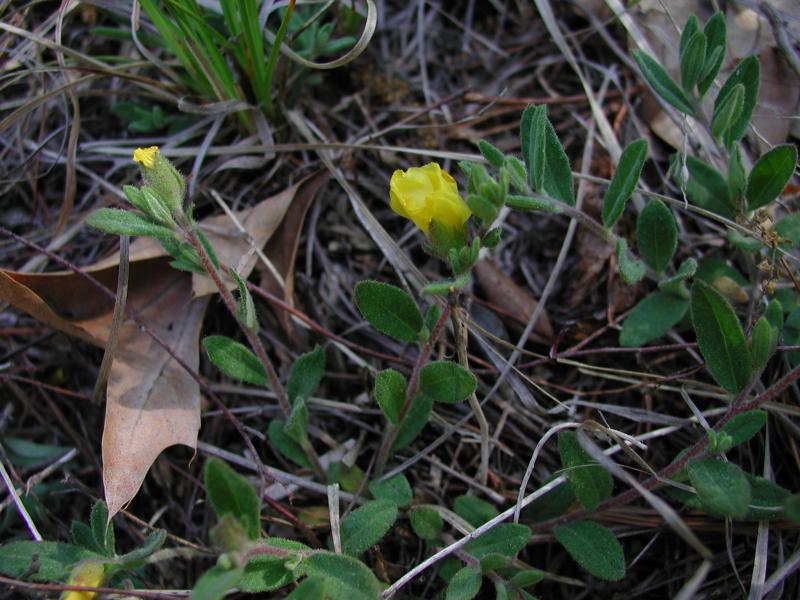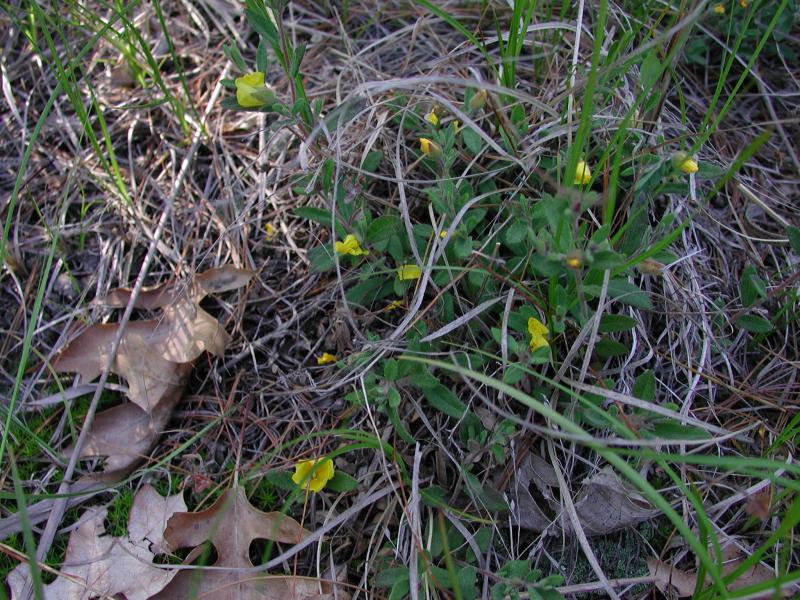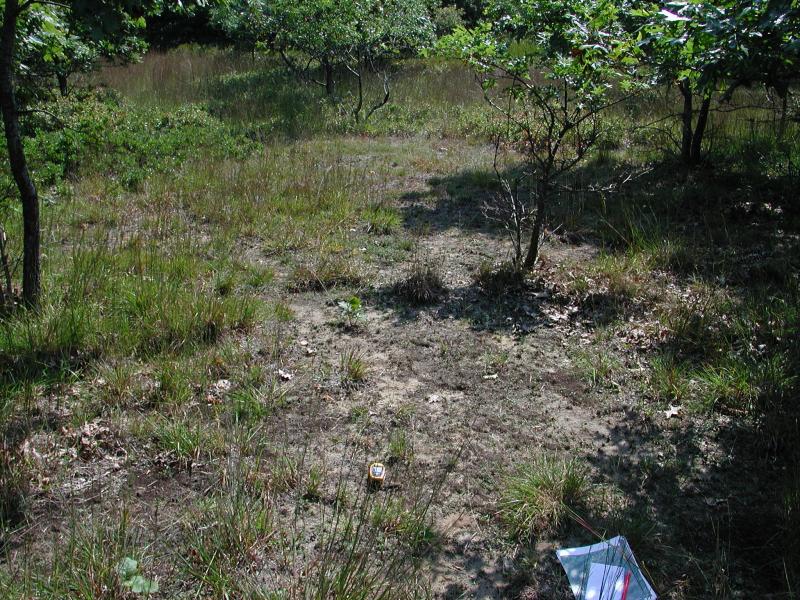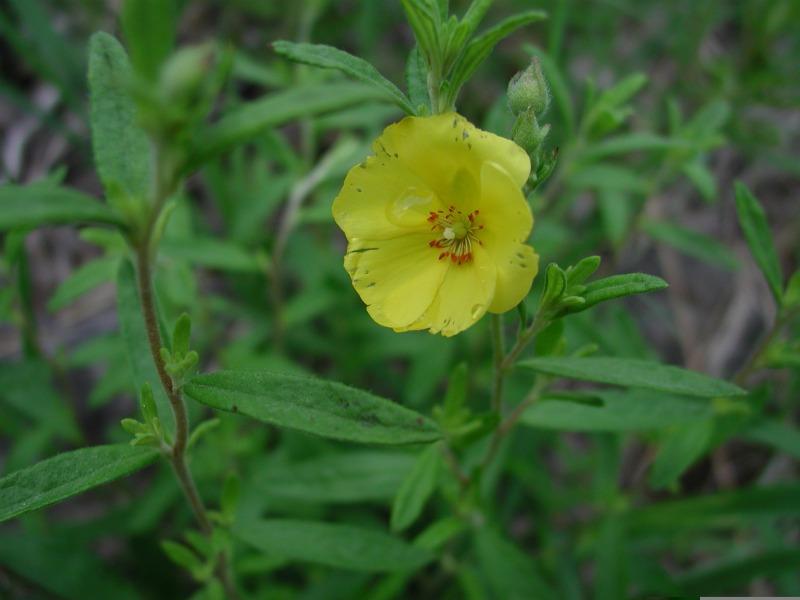Bushy Rock Rose
Crocanthemum dumosum Bickn.
- Class
- Dicotyledoneae (Dicots)
- Family
- Cistaceae (Rock-Rose Family)
- State Protection
- Threatened
Listed as Threatened by New York State: likely to become Endangered in the foreseeable future. For animals, taking, importation, transportation, or possession is prohibited, except under license or permit. For plants, removal or damage without the consent of the landowner is prohibited.
- Federal Protection
- Not Listed
- State Conservation Status Rank
- S2
Imperiled in New York - Very vulnerable to disappearing from New York due to rarity or other factors; typically 6 to 20 populations or locations in New York, very few individuals, very restricted range, few remaining acres (or miles of stream), and/or steep declines.
- Global Conservation Status Rank
- G3
Vulnerable globally - At moderate risk of extinction due to rarity or other factors; typically 80 or fewer populations or locations in the world, few individuals, restricted range, few remaining acres (or miles of stream), and/or recent and widespread declines.
Summary
Did you know?
Robert Zaremba, botanist from Cape Cod, calls bushy rockrose the signature species of the maritime grasslands since its beautiful yellow flowers are always present in large healthy examples of this community. The genus name is derived from the Greek for sunflower and refers to the yellow flowers that open only once, when the sun is shining, before the petals fall off. The species name means bushy.
State Ranking Justification
There are 12 existing populations, but only 2 of them are large and extensive. The remainder occur in fairly small patches. There are nine historical occurrences, but 6 of them are considered extirpated.
Short-term Trends
Populations fluctuate, sometimes substantially, from year to year, but overall they seem stable as counts are done on most populations every year. One population from 1984 was subsequently destroyed by development. Three populations need recent counts.
Long-term Trends
Populations have been stable over the long term as new populations have been found to replace those that have been extirpated on western Long Island. The present populations seem large enough to remain stable for the foreseeable future.
Conservation and Management
Threats
The biggest threat to this species is succession of its maritime grassland habitat to woody species, although a seed bank can maintain the population for some time until disturbance returns. Some populations also occur along trails or roads where the open habitat is maintained, but the plants are still threatened by direct disturbance such as trampling, improper mowing, or bicycle use.
Conservation Strategies and Management Practices
This species needs disturbance to reduce competition from woody plants or more aggressive herbaceous plants, but too much direct disturbance to the plants will reduce the population. Its habitat could be disturbed in the non-growing season, especially with fire, to open it up for seed germination and colonization, but direct disturbance should be prevented during the growing season.
Research Needs
Some taxonomic work has been done on this species but results are inconclusive. More research is needed on how the characters of this plant change throughout the season.
Habitat
Habitat
In New York State, Crocanthemum dumosum is known from a number of diverse habitats on Long Island, with dry sandy soils being the common factor. It has been found growing in maritime heathlands, shrublands and grasslands, in Hempstead Plains grasslands, in oak woodlands and openings within oak hickory, oak-pine, and oak-maple forests, and in disturbed areas within lawns, golf courses, and pipelines (New York Natural Heritage Program 2010). Dry, sandy soil and barrens (Gleason and Cronquist 1991). Open, dry, sandy slopes with less than 25% herb cover; plants seem to be intolerant of shade and moisture (Coddington 1978). Dry sands, barrens and open woods (Fernald 1970).
Associated Ecological Communities
- Coastal oak-hickory forest
(guide)
A hardwood forest with oaks and hickories codominant that occurs in dry, well-drained, loamy sand of knolls, upper slopes, or south-facing slopes of glacial moraines of the Atlantic Coastal Plain.
- Hempstead Plains grassland
(guide)
A tall grassland community that occurs on rolling outwash plains in west-central Long Island. This community occurs inland, beyond the influence of offshore winds and salt spray.
- Maritime grassland
(guide)
A grassland community that occurs on rolling outwash plains of the glaciated portion of the Atlantic coastal plain, near the ocean and within the influence of offshore winds and salt spray.
- Maritime heathland
(guide)
A dwarf shrubland community that occurs on rolling outwash plains and moraine of the glaciated portion of the Atlantic coastal plain, near the ocean and within the influence of onshore winds and salt spray.
- Maritime shrubland
(guide)
A shrubland community that occurs on dry seaside bluffs and headlands that are exposed to offshore winds and salt spray.
- Mowed lawn with trees
Residential, recreational, or commercial land in which the groundcover is dominated by clipped grasses and forbs, and it is shaded by at least 30% cover of trees. Ornamental and/or native shrubs may be present, usually with less than 50% cover. The groundcover is maintained by mowing and broadleaf herbicide application.
- Pitch pine-oak forest
(guide)
A mixed forest that typically occurs on well-drained, sandy soils of glacial outwash plains or moraines; it also occurs on thin, rocky soils of ridgetops. The dominant trees are pitch pine mixed with one or more of the following oaks: scarlet oak, white oak, red oak, or black oak.
- Pitch pine-oak-heath woodland
(guide)
A pine barrens community that occurs on well-drained, infertile, sandy soils. The structure of this community is intermediate between a shrub-savanna and a woodland. Pitch pine and white oak are the most abundant trees.
Associated Species
- Arctostaphylos uva-ursi (bearberry)
- Carex pensylvanica (Pennsylvania sedge)
- Chrysopsis mariana (Maryland golden-aster)
- Danthonia spicata (poverty grass)
- Helianthemum canadense
- Helianthemum propinquum
- Hudsonia tomentosa (beach-heather)
- Ionactis linariifolius
- Lechea maritima
- Liatris borealis
- Luzula bulbosa (bulbous wood rush)
- Lyonia mariana (staggerbush)
- Myrica pensylvanica
- Opuntia humifusa (eastern prickly-pear)
- Polytrichum commune
- Quercus alba (white oak)
- Quercus stellata (post oak)
- Quercus velutina (black oak)
- Schizachyrium scoparium
Range
New York State Distribution
This is currently only known from Nassau and Suffolk counties on Long Island.
Global Distribution
This small herb is known from southeastern Massachusetts (all but one are on Cape Cod and the surrounding Islands), southeastern Rhode Island and Block Island, southeastern Connecticut, and Long Island.
Identification Comments
General Description
Bush Rockrose is a low-growing (up to 30 cm) perennial herb species with widely spreading branches. The leaves are alternate, 2 to 3 cm long, and densely hairy on their upper sides. It first bears open, solitary flowers with yellow petals 8 to 15 mm long, and later closed, cleistogamous flowers borne in the axils or tips of leafty branchlets. The fruit are capsules; those of open flowers are 4 to 7mm long with 16 to 50 seeds, and those of the cleistogamous flowers 3 to 4.5 mm long with 8 to 14 seeds.
Best Life Stage for Proper Identification
Plants with leaves and either flowers or capsules are best for identification.
Similar Species
There are four different Crocanthemum species in New York and these are often confused with one another. Crocanthemum bicknellii is very tall relative to other Crocanthemum species and the stems are densely covered with white hairs. Crocanthemum propinquum is clearly clonal and the stems have few branches and are moderately covered with white hairs. Both Crocanthemum bicknellii and C. propinquum have inflorescences of 2 to 10 or more petaliferous flowers, and the capsules of their cleistogamous flowers have 1-2 (3) seeds. Crocanthemum canadense is the species most difficult to distinguish from C. dumosum. It has strongly ascending branches and branchlets at maturity, compared to the widely divergent to almost horizontal branching of C. dumosum (which often looks stomped on), tends to bloom later, and the seeds of its cleistogamous flowers are on average smaller (2-3 mm) and fewer (5-10 per flower).
Best Time to See
Crocanthemum dumosum flowers from mid-May into late June. Fruits may persist through mid-October.
- Flowering
- Fruiting
The time of year you would expect to find Bushy Rock Rose flowering and fruiting in New York.
Bushy Rock Rose Images
Images of Similar Species
Taxonomy
Bushy Rock Rose
Crocanthemum dumosum Bickn.
- Kingdom Plantae
- Phylum Anthophyta
- Class Dicotyledoneae
(Dicots)
- Order Violales
- Family Cistaceae (Rock-Rose Family)
- Order Violales
- Class Dicotyledoneae
(Dicots)
- Phylum Anthophyta
Additional Common Names
- Bushy Frostweed
- Bushy Rockrose
Synonyms
- Helianthemum dumosum (Bickn.) Fern.
Comments on the Classification
Arrington and Kubitzki (2003) proposed reviving the segregate genus Crocanthemum for New World members of Helianthemum sensu lato based on morphology, nuclear and chloroplast DNA phylogenies, and geography. Their molecular work also shows that Hudsonia is
Additional Resources
Best Identification Reference
Reschke, Carol. 1990. Ecological communities of New York State. New York Natural Heritage Program, New York State Department of Environmental Conservation. Latham, NY. 96 pp. plus xi.
Other References
Coddington, J. and K.C. Field. 1978. A report prepared for the U.S. Fish and Wildlife Service. Newton Corner, MA. 10 pp.
Crow, Garrett E. 1982. New England's Rare, Threatened, and Endangered Plants. Prepared for the United States Department of Interior, Fish and Wildlife Service, Northeast Region. June 1982.
Daoud, H.S. and R.L. Wilbur. 1965. A revision of the North American species of Helianthemum (Cistaceae). Rhodora 67: 63-314 (interrupted pagination).
Fernald, M.L. 1917. Helianthemum dumosum on the mainland of New England. Rhodora 19: 58-60.
Fernald, M.L. 1950. Gray's manual of botany. 8th edition. D. Van Nostrand, New York. 1632 pp.
Gleason, Henry A. and A. Cronquist. 1991. Manual of Vascular Plants of Northeastern United States and Adjacent Canada. The New York Botanical Garden, Bronx, New York. 910 pp.
Holmgren, Noel. 1998. The Illustrated Companion to Gleason and Cronquist's Manual. Illustrations of the Vascular Plants of Northeastern United States and Adjacent Canada. The New York Botanical Garden, Bronx, New York.
Mitchell, Richard S. and Charles J. Sheviak. 1981. Rare Plants of New York State. Bull No. 445. New York State Museum. Univ. of New York. State Ed. Department Albany, NY.
Mitchell, Richard S. and Gordon C. Tucker. 1997. Revised Checklist of New York State Plants. Contributions to a Flora of New York State. Checklist IV. Bulletin No. 490. New York State Museum. Albany, NY. 400 pp.
New York Natural Heritage Program. 2024. New York Natural Heritage Program Databases. Albany, NY.
Weldy, T. and D. Werier. 2010. New York flora atlas. [S.M. Landry, K.N. Campbell, and L.D. Mabe (original application development), Florida Center for Community Design and Research http://www.fccdr.usf.edu/. University of South Florida http://www.usf.edu/]. New York Flora Association http://newyork.plantatlas.usf.edu/, Albany, New York
Links
About This Guide
Information for this guide was last updated on: February 24, 2011
Please cite this page as:
New York Natural Heritage Program. 2024.
Online Conservation Guide for
Crocanthemum dumosum.
Available from: https://guides.nynhp.org/bushy-rockrose/.
Accessed July 26, 2024.




